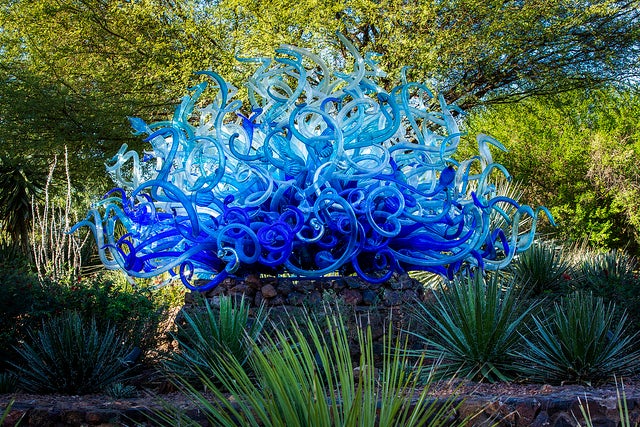Student team examines economic impact of community art exhibit
In fall 2013, the Desert Botanical Garden in Phoenix followed up on its record-setting exhibition with Chihuly in the Garden, bringing the renowned artist, Dale Chihuly back for a second time. His stunning creations complemented the Garden’s vast desert landscape and attracted visitors from the local community and around the world.
But did the effect of the exhibit go beyond the garden? A group of doctoral students in the School of Community Resources and Development, part of the College of Public Programs at Arizona State University, sought to understand the economic impact of the exhibition as part of a field work project.
The results of their work show significant impact on the region—both economic and quality of life.
More than 630,000 people attended Chihuly in the Garden. It is estimated that about 30,000 were from out of town and cited the exhibition as a major factor in their decision to visit Phoenix.
Attendees spent over $22 million while visiting Phoenix. Their expenditures created over 365 jobs, $13 million in income, a $21 increase in gross regional product and $2 million in state and local tax revenue.
Garden director, Ken Schutz, noted, “We knew that the Chihuly in the Garden would have a very positive effect on the Garden’s finances. But it was especially rewarding to learn from the ASU study the magnitude of the positive impact on the broader community. What we did at the Garden actually created a $22 million economic “ripple” that reverberated throughout our entire community. More and more, people are coming to see arts and culture as an economic engine--one that simultaneously increases the quality of life in our community and which adds greatly to the vitality of the local economy.”
The students surveyed attendees over 14 randomly selected days during the exhibition. Data collected was analyzed using IMPLAN modeling software.
“We want to quantify the importance of the arts in economic and community development,” says Kathleen Andereck, director of the School of Community Resources and Development. “Investments in these types of exhibitions bring not only financial gains through tourism, but economic and quality of life improvement for residents.”
Part of the school’s tourism development research looks at different ways in which communities can be improved. Partnerships like the ASU-Desert Botanical Garden collaboration give students hands-on research experience—while simultaneously helping local organizations measure their efforts.
“The Desert Botanical Garden project allowed me the unique opportunity to work in a team environment with my peers and faculty to get hands on experience in developing and executing a full research study,” says Tiffanie Ord who is pursuing a Ph.D. in community resources and development. “It is through my engagement with this project that I gained deeper knowledge in the areas of developing a survey instrument, collecting surveys in the field, working with data in SPSS, conducting a photo analysis from a social media website, and presenting final project results to the DBG team. I appreciate the time spent by the CRD faculty in mentoring us and managing this study as well as the efforts of the DBG team to make the study a positive and successful experience for all involved.”
The Chihuly in the Garden exhibit was made possible by funding from Chase, JP Morgan and APS. The exhibit ran from November 10, 2013-May 18, 2014.
A “Phoenix Point of Pride”, the Desert Botanical Garden is one of only a few botanical gardens accredited by the American Association of Museums. It is a privately funded, non-profit organization and depends on revenues from admissions and gift shop sales, as well as contributions from individuals and businesses to fund its programs of environmental education, plant conservation and research. For more information on the Desert Botanical Garden, visit dbg.org.
